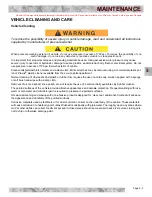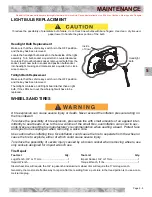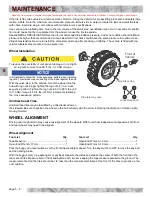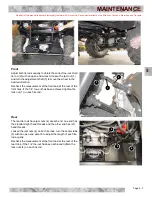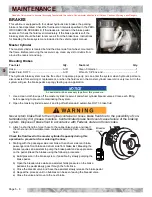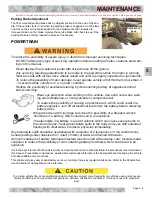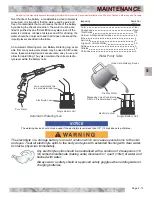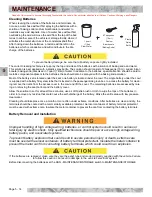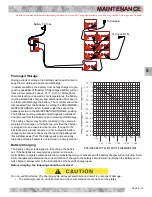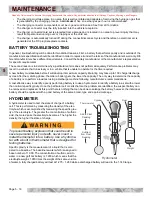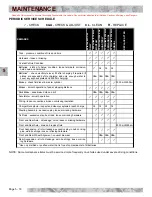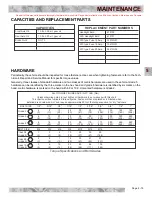
Page 5 - 17
MAINTENANCE
Read all of this manual to become thoroughly familiar with this vehicle. Pay particular attention to all Notices, Cautions, Warnings, and Dangers.
5
Do not perform a hydrometer test on a battery that has just been watered. The battery must go through at least one charge and
discharge cycle in order to permit the water to adequately mix with the electrolyte.
The temperature of the
electrolyte
is important since the hydrometer reading must be corrected to 80° F (27° C). High
quality hydrometers are equipped with an internal thermometer that will measure the temperature of the electrolyte and
will include a conversion scale to correct the float reading. It is important to recognize that the electrolyte temperature is
significantly different from the ambient temperature if the vehicle has been operated.
Using A Hydrometer
1. Draw electrolyte into the hydrometer several times to per-
mit the thermometer to adjust to the electrolyte tempera-
ture and note the reading. Examine the color of the
electrolyte. A brown or gray coloration indicates a prob-
lem with the battery and is a sign that the battery is near-
ing the end of its life.
2. Draw the minimum quantity of electrolyte into the
hydrometer to permit the float to float freely without con-
tacting the top or bottom of the cylinder.
3. Hold the hydrometer in a vertical position at eye level and
note the reading where the electrolyte meets the scale on
the float.
4. Add or subtract four points (.004) to the reading for every
10° F (6° C) the electrolyte temperature is above or below
80° F (27° C). Adjust the reading to conform with the
electrolyte temperature, e.g., if the reading indicates a
specific gravity of 1.250 and the electrolyte temperature
is 90° F (32° C), add four points (.004) to the 1.250 which
gives a corrected reading of 1.254. Similarly if the tem-
perature was 70° F (21° C), subtract four points (.004)
from the 1.250 to give a corrected reading of 1.246.
5. Test each cell and note the readings (corrected to 80° F
or 27° C). A variation of fifty points between any two cell
readings (example 1.250 - 1.200) indicates a problem
with the low reading cell(s).
As a battery ages the specific gravity of the electrolyte will
decrease at full charge. This is not a reason to replace the
battery providing all cells are within fifty points of each other.
Since the hydrometer test is in response to a vehicle exhibit-
ing a performance problem, the vehicle should be recharged
and the test repeated. If the results indicate a weak cell, the
battery or batteries should be removed and replaced with a
good battery of the same brand, type and approximate age.
NOTICE
Hydrometer Temperature Correction
°F °C
160 71
150 65
140 60
130 54
120 49
110 43
100 37
90 32
80 26
70 21
60 15
50 10
40 4
30 -1
20 -6
10 -12
+.032
+.028
+.024
+.020
+.016
+.012
+.008
+.004
0
-.004
-.008
-.012
-.016
-.020
-.024
-.028
+.030
+.026
+.022
+.018
+.014
+.010
+.006
+.002
-.002
-.006
-.010
-.014
-.018
-.022
-.026
EXAMPLE #1
ELECTROLYTE TEMPERATURE
Above 80 °F (27 °C)
AMBIENT TEMPERATURE
Above 80 °F (27 °C)
ELECTROLYTE TEMPERATURE
Above 90 °F (32 °C)
HYDROMETER READING 1.250
1.250 + .004 = 1.254
CORRECTED SPECIFIC GRAVITY
READING
EXAMPLE #2
ELECTROLYTE TEMPERATURE
Above 80 °F (27 °C)
AMBIENT TEMPERATURE
Above 80 °F (27 °C)
ELECTROLYTE TEMPERATURE
Above 70 °F (21 °C)
HYDROMETER READING 1.250
1.250 - .004 = 1.246
CORRECTED SPECIFIC GRAVITY
READING
ELECTROLYTE
TEMPERATURE

